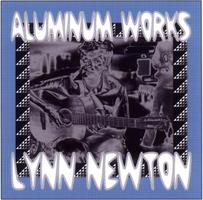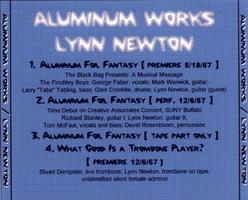

| Neologistics→ Music → Aluminum |
The artwork for Aluminum Works was created by Charles Wolff, and also all the grunt work of extracting it from tapes. A short discussion of each recording follows the cover images. I may MP3s later. Click on either image to see it full size.
I've written extensively about this work (which I abbreviate tAFF) as a supplement to the notes for Before There Was Time.
Whether you like or hate the the piece or are interested in it or not, one point remains inarguable — you've never heard a piece like it before. tAFF is a long, atonal rock piece in three sections, with electronic tape accompaniment in the middle part. In case you wonder, the piece sounds like so much noise, even to me, but largely because of the sloppy performances and poor microphone placement on the recording of the second version. I still believe today that tAFF is at least interesting from a historical standpoint, and worth knowing about. If I had the proper opportunity, which would include a guaranteed performance by a band that knew how to handle it, I'd consider reworking it or even recreating it. I believe it could be exciting to listen to if properly produced and shortened considerably. The first performance is 18:27, and the second is 22:33.
The first performance on the CD is played by the Finchley Boys, a group of teenagers that went on to some Chicago area fame. I taught it to them by rote, and joined them as guest second guitarist. The performance is chaotic, but passionate.
The occasion was a concert of new works two friends and I presented, which we called The Black Bag Presents: Musical Massage. We were to produce two more concerts immediately afterward, but were much too exhausted by the all out effort we put into the first Black Bag concert to do any more at that time.
It was shortly after the Black Bag concert that I formed my band, which was known first as Time, then as Think Dog! At our debut concert (we were not a dance club band!) we played a set of four pieces, including this version of The Aluminum Foil Fantasy, on a Creative Associates concert at State University of New York in Buffalo, New York. The other three works are on Whatever Works.
It's my assessment that our performance of this was overall technically better than the Finchley Boys. However, the recording quality of the Time performance is very bad because of poor microphone placement. (The stage was set up for chamber music, not a rock and roll band with its own sound system and electronic tape accompaniment emanating from another source.) Also, I believe we play the third part too fast, so much so that the offbeat chops become rushed, and it loses the backbeat effect I intended. C'est la vie.
It's a miracle that this tape exists at all. I discovered almost by accident while prowling the Internet that the concert had been recorded (which I never knew) and the tapes preserved in the SUNY music library. I was able to get a copy on request for the cost of duplication over thirty years later.
The middle section of The Aluminum Foil Fantasy consists of an improvisation wrapped around an electronic tape piece, which was supposed to be played through speakers to the rear of the audience. I no longer remember if we were able to arrange that at SUNY, but that's how we did it on the Black Bag concert.
The tape part doesn't come across very well on either recording. The playing of the Finchley Boys on this was lousy, though the recording itself is reasonably audible. On the other hand, as musicians familiar with the language, Time was able to react much better to the tape, but the tape part is largely buried on the recording.
This recording presents just the tape part by itself, in order to give it a fair hearing. Note that there is a deliberate 40-second period of dead silence on the tape beginning at right about 2:00. Time used this space to pantomime playing in slow motion with subdued lights. The Finchley Boys scratched on their instruments, wondering what to do next, until the music on the tape started again.
Two days after the first Black Bag concert, I had to get to work on new music for the second one, which was to be in a couple of weeks. There was no time whatever to create and rehearse anything complex. I decided to supply a theater piece with a humorous twist. What Good Is a Trombone Player?, for trombone, tape, and girl, was created in one long morning session, probably on May 20, 1967.
By this time I had become preoccupied with playing rock and roll, and was losing interest in playing trombone. So in this work I answered the musical question asked in the title.
I went to the University of Illinois electronic music studio with my trombone and a coffee can, and proceeded to record over seventeen minutes of trombone improvisation using the following rules: I played only pitches between middle B-flat and G-flat (first to fifth positions), including all microtones in between; I played primarily slipping, gliding sounds; I often enriched the sound, producing a ring modulator-like beating sound, by humming into the instrument at the same time (something I used to practice and was pretty good at); I used the aluminum coffee can like a wah-wah or plunger mute.
It didn't help that I was sick as a dog when I made this tape, a condition brought on by exhaustion from producing the first concert. After laying down one track, I put my head on the table and rested for ten minutes or so to avoid throwing up. Then I ran the original track backwards and recorded over it on the other channel. I repeated this sequence, including resting my head on the table, until I had recorded what amounted to a four-channel trombone choir. Over that, a live player would perform a fifth track following the same rules.
When I was done, I used a timer and a notepad while listening to the whole thing to mark timings at which specific visual events were to take place. Then I went home to make a master copy of the instructions, intending to play it myself, with the assistance of a female friend named Valerie.
If you have read this far, by now you are certainly wondering: What was the role of the "girl?" The best thing I can say, after all these years, is that her function was ... ummm ... to admire the trombone player, sitting quietly on the sidelines, periodically oohing and ahhing, and eventually advancing upon him affectionately while he played. I'll leave the remainder of what happened to your imagination.
The silent "girl" in the performance was an actress friend of Stuart Dempster, whose name never made the program, and which I no longer remember. Credit should be given also to Stuart's wife for being a good sport about the whole thing.
It happened that a music critic from the newspaper came to our concert. Although the whole focus and purpose of it was to debut our band Time, the critic had to leave early, and never heard a note of the band. Therefore, he wound up writing a full column-and-a-half review that dwelled almost entirely on What Good Is a Trombone Player? The review, although highly favorable, was pretentious hooey, in which he compared the work to an endless passacaglia. He was probably too busy writing notes to realize he was being subjected to a drone, and to notice the humor that was taking place on stage.
As an amusing conclusion to this, it just happened that my landlady Mrs. Fillmore, who was not sure I had a real job (actually, I didn't), saw the glowing review in the newspaper the next day, and was so proud that I was her tenant that she regularly fed me free dinners and leftover baked goods for the next six months. I wonder if she would have been as impressed if she'd actually heard the piece?